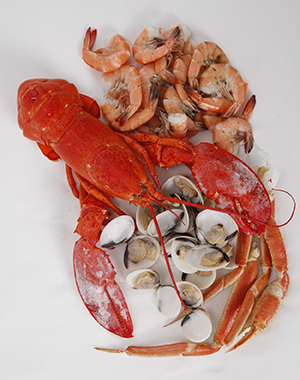When Your Child Has a Food Allergy: Shellfish

When a child has a shellfish allergy, coming in contact with even a small amount of shellfish can cause a life-threatening reaction. This sheet tells you more about your child’s shellfish allergy. You’ll learn what foods your child should stay away from, what to look for on food labels, and how your child can eat safely in restaurants.
Shellfish allergy: What to stay away from
Most children shouldn't eat any kind of shellfish. But some children are allergic to some types of shellfish and not others. Ask your child’s healthcare provider whether your child should stay away from all shellfish, or just certain types. Types of shellfish include:
-
Abalone
-
Anchovies. These are not a shellfish. But they contain a protein that's like the protein in shellfish. These are often found in Caesar salads and Caesar dressing.
-
Calcium supplements made from coral
-
Clams. These include cherrystone, little neck, geoduck, pismo, and quahog.
-
Cockle, periwinkle, and sea urchin
-
Crab
-
Crawfish (also called crayfish) and écrevisse
-
Cuttlefish
-
Limpet (lapas and opihi)
-
Lobster and langoustines (a type of lobster)
-
Mollusks
-
Mussels
-
Oysters and squid (calamari)
-
Scallops
-
Sea urchin and sea cucumber (bêche-de-mer)
-
Shrimp and prawns
-
Snails, whelks, and periwinkles
Some children with shellfish allergies are also allergic to other fish, such as salmon, trout, and tuna. Ask your child’s healthcare provider whether other types of fish are safe.
What to look for on food labels
U.S. manufacturers of packaged food items must state clearly on the label if the item contains shellfish. Always read the entire ingredient label to look for shellfish. Shellfish ingredients may be within the list of the ingredients. Or shellfish could be listed in a “contains shellfish" statement under the list of ingredients. Any food with shellfish should identify the type of shellfish in the food, such as clams, crab, or lobster.
Foods that don't contain shellfish could be contaminated during manufacturing. Unfortunately, labels like "processed in a facility that also processes shellfish" or "made on shared equipment" are not regulated by the FDA. They are voluntary. Talk with your child’s healthcare provider about whether your child may eat products with these labels or if they should stay away from them.
Some foods and products don't have to state that they contain shellfish. These include:
-
Foods not regulated by the FDA
-
Cosmetics and personal care items
-
Prescription and over-the-counter medicines and supplements
-
Toys and crafts
-
Pet food
Eating out safely
Some children are more sensitive to shellfish than others. Just breathing the fumes of cooking shellfish may trigger an allergic reaction in certain children. For your child’s safety, follow these precautions when eating away from home:
-
Don't eat at seafood restaurants. It’s likely that shellfish may come in contact with foods your child can safely eat.
-
Ask about fried foods such as chicken fingers and french fries. Many restaurants cook chicken, french fries, and shrimp in the same oil.
-
Ask about grilled foods. Chicken, beef, and shrimp may be cooked on the same grill.
-
Ask your server about ingredients and how food is prepared instead of relying on menu descriptions.
-
Don't let your child have paella, bouillabaisse, scampi, sushi, and surimi. These are dishes and foods that often contain shellfish.
-
Carry a “chef card.” This special card explains your child’s food allergy to restaurant workers. You can make your own card or print one from a website on the Internet.
-
Always carry two epinephrine auto-injectors. Make sure you and those close to your child know how to use it.
-
Have your child wear a medical alert bracelet or necklace with their allergy information. If your child doesn’t have epinephrine auto-injectors, talk with your child’s healthcare provider to see if you should carry them.
-
Have your child's healthcare provider make an anaphylaxis action plan in case of an accidental exposure to shellfish. Go over this plan with everyone who cares for your child.
Create a safety plan
-
Always carry two epinephrine auto-injectors. Make sure you and those close to your child know how to use it.
-
Have your child wear a medical alert bracelet or necklace with their allergy information. If your child doesn’t have epinephrine auto-injectors, talk with your child’s healthcare provider to see if you should carry them.
-
Have your child's healthcare provider make an anaphylaxis action plan in case of an accidental exposure to shellfish. Go over this plan with everyone who cares for your child.
Call 911
If your child has any of the symptoms listed below, act quickly. Use an epinephrine auto-injector right away if one has been prescribed. Then call 911.
-
Trouble breathing or cough that won’t stop
-
Swelling of the mouth or face
-
Dizziness or fainting
-
Vomiting or severe diarrhea